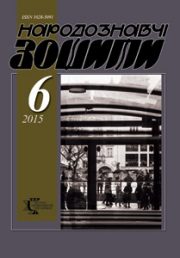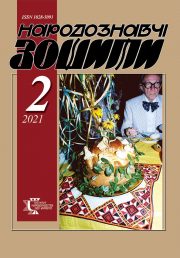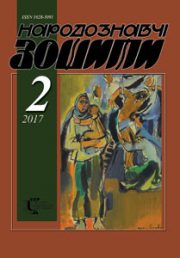The Ethnology Notebooks. 2025. № 3 (183), 578—588
UDK [391:746.077](477.82)
DOI https://doi.org/10.15407/nz2025.03.578
PEREVERTNIUK Ihor
- ORCID ID: https://orcid.org/0000-0001-7111-0678
- Post-graduate student,
- Ethnology Institute National Academy of Sciences of Ukraine,
- 15, Svobody Avenue, 79000, Lviv, Ukraine,
- Contacts: e-mail: igor.perevertniuk@gmail.com
Abstract. The «Serpanok» workshop emerged during the implementation of an ambitious project aimed at reconstructing the «serpanok» — a translucent linen fabric prevalent in the late 19th and early 20th centuries in the Dubrovytskyi district of the Rivne region. Initiated in 2011 in Radyvyliv by local historian Volodymyr Dzyobak, the project culminated in a successful presentation. To preserve and expand upon the acquired expertise, Dzyobak established the «Serpanok» workshop, naming it in honor of the completed weaving project. Today, the workshop stands as a unique creative collective dedicated to reproducing traditional folk clothing from Volyn and Polissya.
The research focuses on the ethnic and artistic phenomenon of workshops dedicated to reproducing Ukrainian folk attire. Specifically, it examines the emergence and operational dynamics of the «Serpanok» workshop. The objective of the article is to analyze this phenomenon through the case study of the «Serpanok» workshop.
The primary sources for this study include an interview with Volodymyr Dzyobak, the workshop’s founder and director, and photographic materials gathered during interviews conducted at the Ladomyriya Ethnopark sites. The study’s novelty lies in the author’s fieldwork and the analysis of the Ladomyriya Ethnopark’s activities, emphasizing its creative and experimental component — the «Serpanok» art workshop focused on reproducing traditional Ukrainian clothing. Methodologically, the research employs a systematic approach, utilizing interviewing, comparative analysis, structuring, and critical analysis techniques.
The relevance of this work is underscored by the fact that workshops dedicated to reproducing traditional clothing remain a relatively underexplored ethnic and artistic phenomenon in the 21st century — a period marked by rapid cultural globalization and homogenization. The establishment of such workshops responds to the pressing need to preserve national identity, with folk attire serving as a significant marker of cultural heritage.
Keywords: Ukrainian traditions, traditional clothing, creative workshop, Volyn, Polissya, weaving, embroidery.
Received 9.05.2025
REFERENCES
- Jurkuviene, T. (2017). Reconstruction and Production of the Lithuanian Folk Costume in the 20th Century. Liaudies kultura, 4, 30—51 [in Lithuanian].
- Semchuk, L. (2022). The Activity of the Art Space «Magda Dzwon’s Workshop» in the Context of the Revival of Ukrainian Folk Embroidery in the Early 21st Century. The Ethnology notebooks, 4 (166), 928—937 [in Ukrainian].
- Nykorak, O. (2020). Radyvyliv Center of Weaving: Revival of Traditions. The Ethnology notebooks, 4 (154), 782—796 [in Ukrainian].
- Nykorak, O. (2023). Ukrainian Folk Fabrics of the 19th—20th Centuries: Typology, Localization, Artistic Features. Part II. Clothing Fabrics (Based on Materials from Western Ukraine). Lviv: Institute of Ethnology of the National Academy of Sciences of Ukraine [in Ukra inian].
- Perevertniuk, I., & Fedorchuk, O. (2023). Private Collecting and Artistic Practices in the Recreation of Ukrainian Traditional Clothing. In: Authentication and Conservation of Cultural Heritage. Research and Technique. Special Issue: Materials of the VIII International Scientific Conference «Cultural Heritage of Yesterday — Implications for the Development of a Sustainable Society Tomorrow» (Pp. 396—402). Chisinau: Academy of Sciences of Moldova; State University of Moldova. Retrieved from: https://zenodo.org/records/8397382 [in Ukrainian].
- Perevertniuk, I. (2024). The Collecting and Creative Activity of Halyna Hafiychuk in the Context of Preserving and Enhancing Cultural Heritage. The Ethnology notebooks, 2 176), 398—406 [in Ukrainian].
- Ukrainets, A. (1996). Traditional Clothing of the Residents of Rivne Region: A Brief Historical Overview. Scientific Notes of the Rivne Regional Local Lore Museum (Pp. 95—102) [in Ukrainian].
- Ukrainets, A. (2019). Traditional Clothing of Rivne Region (Book 1). Rivne: Rivne Regional Local Lore Museum; Publishing House «U Farvateri Istyn» [in Ukrainian].
- Tyshkevych, R. (2004). The Art of Embroidery of Rivne Polissya. Ethnocultural Heritage of Polissya, 5, 18—30 [in Ukrainian]
- Tyshkevych, R. (2010). Polissya Serpanok. Scientific Notes of the Rivne Regional Local Lore Museum, 8, 287—294 [in Ukrainian]
- Ponomar, L. (2012). Area Study of Folk Clothing of Polissya. Folk Creativity and Ethnology, 3, 50—56 [in Ukrainian].
- Ponomar, L.H. (2015). Traditional Clothing of Right-Bank Polissya in the Mid-19th — Mid-20th Centuries. Historical and Ethnographic Atlas. Dictionary. Kyiv: Bisnespoligraf [in Ukrainian].
- The page of the «Etnobazar» group on the Facebook. Retrie ved from: https://www.facebook.com/groups/1755 2560 9591389/ (Last accessed: 26.12.2024) [in Ukra inian].
- Page of the group «Ancient Embroidered Shirt» on the Face book. Retrieved from: https://www.facebook.com/groups/ 1776857642544576/ (Last accessed: 26.12.2024) [in Ukrainian].
- Page of the «Antique Things» group on the Facebook. Retrie ved from: https://www.facebook.com/groups/48 40 721 991 39 616/ (Last accessed: 26.12.2024) [in Ukra inian].
- Antiques/Collections. Hobbies, recreation and sports. OLX. Retrieved from: https://www.olx.ua/uk/ (Last accessed: 26.12.2024) [in Ukrainian].
- Vintage Market. Violity. Retrieved from: https://violity.com/ua (Last accessed: 26.12.2024) [in Ukrainian].
- Valko, Oles (Ed.). (2014). Ukrainian Goldsmithing. Dukachi. Album. Series «Ukrainian Folk Art». Lviv: Institute of Collecting Ukrainian Artifacts at the National Academy of Sciences of Ukraine [in Ukrainian].
- Ethnopark «Ladomyria». Wikipedia. Retrieved from: https://uk.wikipedia.org/wiki/Етнопарк_«Ладомирія» (Last accessed: 26.12.2024) [in Ukrainian].
- Ethnopark «Ladomyriia». Retrieved from: https://ladomyriia.com/ (Last accessed: 26.12.2024) [in Ukrainian].
- World Vyshyvanka Day. Wikipedia. Retrieved from: https://uk.wikipedia.org/wiki/Всесвітній_день_вишиванки (Last accessed: 26.12.2024) [in Ukrainian].
- World Vyshyvanka Day. Wikipedia. Retrieved from: https://uk.wikipedia.org/wiki/Всесвітній_день_вишиванки (Last accessed: 26.12.2024) [in Ukrainian].






